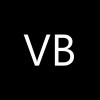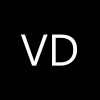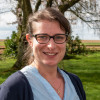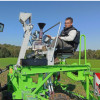Context
In dairy farming, food is the main variable source of expenditure. A more efficient use of the forage resources (EFR) produced is a means of reducing production costs. There are several possible solutions (optimising rations, 'cultivating' grass ...), but breeders are reluctant to resort to some of these because they generate practical and organisational changes for which they feel unprepared. It is therefore essential to study these changes from a technical and human point of view. By finding out what obstacles are encountered during a transition and what strategies are used to circumvent them, and organising the sharing of experiences, the study aims to help facilitate a smoother changeover of systems for farmers.
Improvement of the EFR can begin with a better assessment of the dry matter content and nutritional value of forage. Currently, the analysis turnaround in the field is often lengthy. Moreover, analyses are intermittent, while forage quality varies over time. The ability to analyse forage on the farm would facilitate an ongoing perception of this variability (economic and environmental gains). This example of a change in practice is a move that affects both breeders and their advisors. If it is to be adopted, it is essential to study the reactions to this tool and remove any obstacles.
Furthermore, developing a methodology that supports breeders in these changes, by offering performance indicators and using simulations to show them the impacts of their choice, is a convincing strategy to help them embrace the changes in full knowledge of the facts. Once the CRA-W has adopted this methodological approach, it can be extended to other changes or to other types of agricultural production.
Objectives
The objective of the project is to encourage farmers to make the most of their forage resources. An innovative methodology will be developed to identify dairy farms that have evolved to improve the efficiency of their forage resources (EFR) and determine the reasons for this choice. It will identify the main difficulties encountered by the farmers undertaking this transition and the strategies put in place to remove them. This will make it possible to draft guidelines to make the journey of breeders wishing to optimise their EFR more secure, according to the specific nature of their work.
The project will also work on the development of a key strategy in the optimisation of EFR, namely the development of analytical tools based on near-infrared spectrometry. These tools will give breeders the chance to estimate the dry matter content and, based on its chemical composition, the quality of their forage on site from a fresh sample, at any given moment and virtually instantaneously. Knowing the quality of the forage at the time it is used is a key factor in the optimisation of EFR. Unfortunately, current analysis times are often too long for them to be fully appreciated.
Description of tasks
EFFORT is made up of a coordination WP and 4 operational WPs.
The WP2 will create an EFR inventory and show how it has evolved in Wallonia in recent years, thus adding to the available databases.
Based on the bibliography, the WP2 will pinpoint various indicator systems, taking into account the evolution of the farms over a specified period (10 years). A panel of Walloon specialists will then be interviewed in order to assess the relevance of the indicators selected in defining the EFR. Through collaboration with the AWE and DAEA (provision of multi-year accounting data), these indicators will then be calculated. The correlation between the efficiency indicators and the economic and environmental performance of the farms will be determined. The WP2 is essential for setting the context and defining the variables to be considered in the WP3.
The WP3 will focus on the study of breeders who have improved their EFR. The obstacles met during the transition and the strategies put in place to circumvent them will be analysed. Nowadays, it is no longer enough to study the running of agricultural activities on an annual basis: in order to understand how livestock farms resist and transform, a study of the past has now become an essential source of information (Terrier, 2013). In addition, these studies are generally grounded in a bias towards the agricultural and productive dimension of the farm, and do not examine the family and social dimension. However on farms, many decisions are made for human-specific reasons, or in response to family events (death, marriage, birth, inheritance, changes in the way the workforce is made up…) (Madelrieux et al., 2011). To include this dimension, technical data is no longer sufficient. The human aspect must be taken into account. For this reason, the analysis will focus on quantitative (before and after change) and qualitative (no generation time) data obtained through semi-structured interviews. By analysing farm trajectories, the WP3 will gain knowledge on what has enabled, is enabling and will enable farms to adapt and persist in the agricultural world of tomorrow (Terrier, 2013; al., 2008).
The WP 4 will focus on the development of a strategy to enable producers to make better use of their forage. The approach means that the measuring devices can be brought to the site of production, so that food samples no longer need to be taken to a laboratory. Due to the miniaturisation, portable nature and lower prices of analytical instruments, moving the laboratory to the farm is now within reach of producers and advisers. The benefit of this is that it drastically reduces the response time, enabling the breeder to adapt rations more effectively by carrying out analyses on a more regular basis. Within the WP4 framework, several SPIR portable instruments designed to predict the chemical composition of fresh forage will be tested. The results obtained will be compared with those obtained by the reference method. The approach will involve the creation of a model for each type of fresh forage, and for each variable to be predicted. Once validated, these models will be used routinely for the rapid analysis of large sets of samples from optical data alone.
The WP5 will illustrate the change through different means of communication. In addition to the more traditional means of dissemination (scientific articles, popularisation, lectures…), the project aims to be innovative by using simulation devices to raise awareness among dairy farmers of ways to effect changes. The state of the art has demonstrated that a collective learning dynamic is essential to encourage the acquisition of new practices. In practice, an overly linear pattern of communication of scientific knowledge to practitioners, let alone the agricultural world, does not enable an effective sharing of information (Cash et al., 2003).
Expected results
- Status report illustrating the variability of EFR among Walloon dairy farms and explaining its significance for their economic and environmental viability (WP2).
- Identification of the main driving forces and also the obstacles and difficulties encountered by farmers when attempting to optimise their EFR, by means of farm audits.
- Creation of fact sheets for farmers to help them understand the consequences of their choice within a clearly defined context (WP3).
- Development of analytical tools that enable producers to gain knowledge of forage quality in real time and, if possible, a calculator that provides a prediction of its nutritional value (WP4).
- Issue of an analytical guide for farms to help breeders become familiar with the tools.
In addition to the popular and scientific articles, sector-specific communication through focus groups where breeders can discuss their forage management practices, thus facilitating their transition (WP5).
CRAW off coordinator
Eric FROIDMONT










